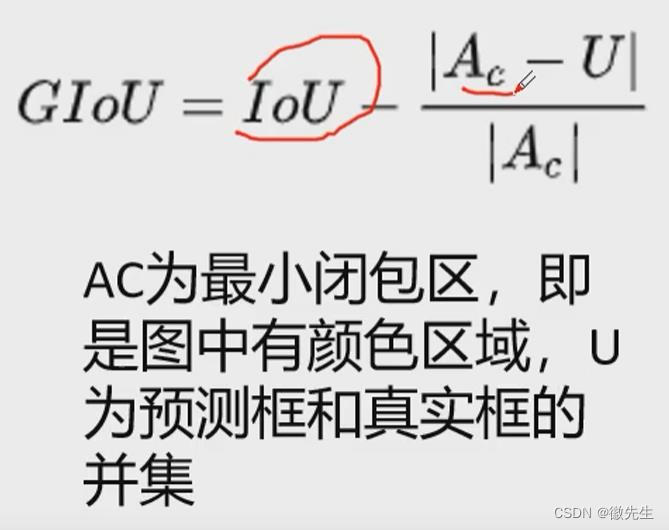yolov5的trick总结
文章目录
- yolov5的trick总结
-
- 输入端的 Mosaic 数据增强
- 自适应锚框计算
- 自适应图片缩放操作
- CSP 结构
- SPP 结构
- FPN + PAN 结构
- IOU_Loss
-
- IOU
- GIOU
- DIOU
- CIOU
yolov5的trick总结
输入端的 Mosaic 数据增强、自适应锚框计算、自适应图片缩放操作、Focus 结构(之后6.0就不用了)、CSP 结构、SPP 结构、FPN + PAN 结构、CIOU_Loss 等等。
输入端的 Mosaic 数据增强
mosaic数据增强则利用了四张图片,对四张图片进行拼接,每一张图片都有其对应的框框,将四张图片拼接之后就获得一张新的图片,同时也获得这张图片对应的框框,然后我们将这样一张新的图片传入到神经网络当中去学习,相当于一下子传入四张图片进行学习了。
- 首先随机取四张图片;
- 分别对四张图片进行数据增广操作,并分别粘贴至与最终输出图像大小相等掩模的对应位置;
- 翻转(对原始图片进行左右的翻转);
- 缩放(对原始图片进行大小的缩放);
- 色域变化(对原始图片的明亮度、饱和度、色调进行改变)等操作。
- 进行图片的组合和框的组合,完成四张图片的摆放之后,我们利用矩阵的方式将四张图片它固定的区域截取下来,然后将它们拼接起来,拼接成一 张新的图片,新的图片上含有框框等一系列的内容——对应的区域被剪裁掉后,框坐标做对应处理。对于过小的目标,则丢弃掉;
自适应锚框计算
- 使用k-means聚类获得最佳的锚框
- 用超参数学习
自适应图片缩放操作
自适应图片缩放letterbox
实现步骤:
- 计算收缩比;
- 计算收缩后图片的长宽;
- 计算需要填充的像素;
- 最后resize图片并填充像素
def letterbox(im, new_shape=(640, 640), color=(114, 114, 114), auto=True, scaleFill=False, stride=32):
# Resize and pad image while meeting stride-multiple constraints
shape = im.shape[:2] # current shape [height, width]
if isinstance(new_shape, int):
new_shape = (new_shape, new_shape)
# Scale ratio (new / old)
r = min(new_shape[0] / shape[0], new_shape[1] / shape[1])
# Compute padding
ratio = r, r # width, height ratios
new_unpad = int(round(shape[1] * r)), int(round(shape[0] * r))
dw, dh = new_shape[1] - new_unpad[0], new_shape[0] - new_unpad[1] # wh padding
if auto: # minimum rectangle
dw, dh = np.mod(dw, stride), np.mod(dh, stride) # wh padding
dw /= 2 # divide padding into 2 sides
dh /= 2
print(dw, dh)
if shape[::-1] != new_unpad: # resize
im = cv.resize(im, new_unpad, interpolation=cv.INTER_LINEAR)
top, bottom = int(round(dh - 0.1)), int(round(dh + 0.1))
left, right = int(round(dw - 0.1)), int(round(dw + 0.1))
im = cv.copyMakeBorder(im, top, bottom, left, right, cv.BORDER_CONSTANT, value=color) # add border
return im, ratio, (dw, dh)
CSP 结构
SPP 结构
金字塔结构
FPN + PAN 结构
FPN 高维度向低维度传递语义信息(大目标更明确)
PAN 低维度向高维度再传递一次语义信息(小目标也更明确)
IOU_Loss
可以自己选择CIOU、DIOU以及GIOU三种IOU的方式。
# IoU
iou = inter / union
if CIoU or DIoU or GIoU:
cw = torch.max(b1_x2, b2_x2) - torch.min(b1_x1, b2_x1) # convex (smallest enclosing box) width
ch = torch.max(b1_y2, b2_y2) - torch.min(b1_y1, b2_y1) # convex height
if CIoU or DIoU: # Distance or Complete IoU https://arxiv.org/abs/1911.08287v1
c2 = cw ** 2 + ch ** 2 + eps # convex diagonal squared
rho2 = ((b2_x1 + b2_x2 - b1_x1 - b1_x2) ** 2 + (b2_y1 + b2_y2 - b1_y1 - b1_y2) ** 2) / 4 # center dist ** 2
if CIoU: # https://github.com/Zzh-tju/DIoU-SSD-pytorch/blob/master/utils/box/box_utils.py#L47
v = (4 / math.pi ** 2) * torch.pow(torch.atan(w2 / (h2 + eps)) - torch.atan(w1 / (h1 + eps)), 2)
with torch.no_grad():
alpha = v / (v - iou + (1 + eps))
return iou - (rho2 / c2 + v * alpha) # CIoU
return iou - rho2 / c2 # DIoU
c_area = cw * ch + eps # convex area
return iou - (c_area - union) / c_area # GIoU https://arxiv.org/pdf/1902.09630.pdf
return iou # IoU
IOU
优点:
- IOU具有尺度不变性;
- 满足非负性;
缺点:
GIOU
针对普通的IOU存在的问题使用GIOU,引入了最小闭包的关系,公式如下所示:
存在的缺陷:

DIOU
引入了中心距离关系,去解决GIOU与IOU相同的情况,其公式如下:

存在的缺陷:


